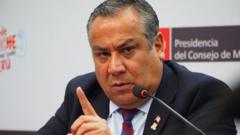Adrianzén’s departure marks the third prime ministerial exit under Boluarte's presidency, heightening the urgency for a cabinet overhaul. According to Peru’s constitution, the resignation of the prime minister necessitates the resignation of all ministers, meaning Boluarte must now navigate the complexities of appointing a new cabinet while managing dwindling approval ratings.
This political crisis comes as the nation grapples with rampant crime and rising public unrest. In response to the growing extortion problem, protests have erupted, with citizens demanding effective measures from their government to ensure safety and stability. Demonstrators have expressed their frustration through placards reading "no more deaths."
Just prior to Adrianzén's resignation, Boluarte attempted a cabinet reshuffle, appointing new ministers to key portfolios, including finance and transport. However, these newly sworn-in ministers now face premature exits, amplifying the chaos within Peru’s governance. The president's approval rating has continued to decline since her ascension following the impeachment of former president Pedro Castillo, as citizens increasingly question her ability to address the urgent issues at hand.
The political situation in Peru will remain a crucial focus as citizens look for effective leadership in overcoming the formidable challenges confronting their country.
This political crisis comes as the nation grapples with rampant crime and rising public unrest. In response to the growing extortion problem, protests have erupted, with citizens demanding effective measures from their government to ensure safety and stability. Demonstrators have expressed their frustration through placards reading "no more deaths."
Just prior to Adrianzén's resignation, Boluarte attempted a cabinet reshuffle, appointing new ministers to key portfolios, including finance and transport. However, these newly sworn-in ministers now face premature exits, amplifying the chaos within Peru’s governance. The president's approval rating has continued to decline since her ascension following the impeachment of former president Pedro Castillo, as citizens increasingly question her ability to address the urgent issues at hand.
The political situation in Peru will remain a crucial focus as citizens look for effective leadership in overcoming the formidable challenges confronting their country.




















